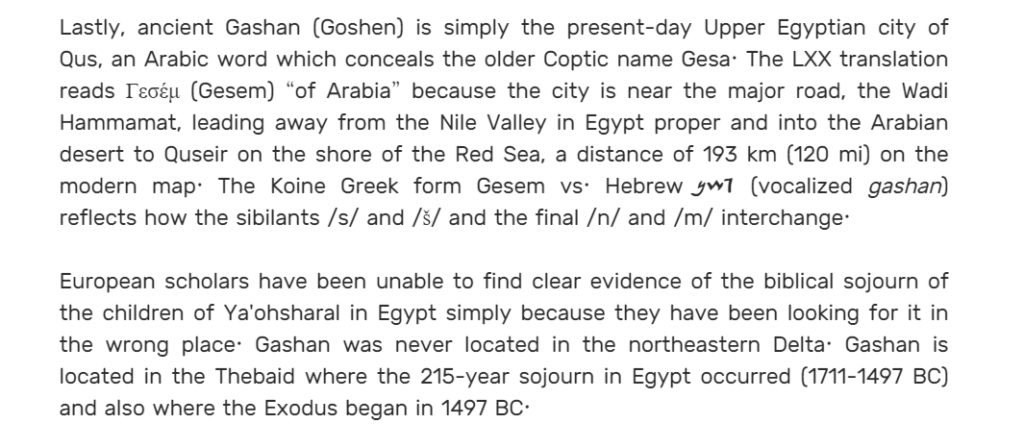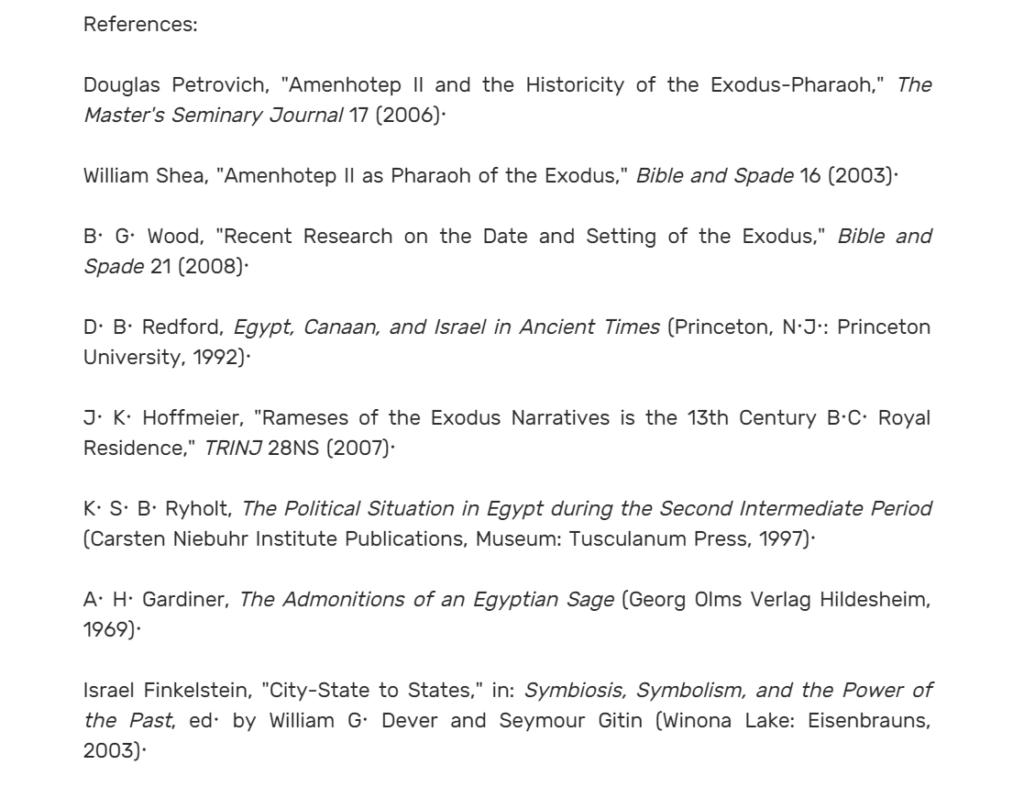According to many European researchers, the biblical toponym Gashan (i.e. Goshen) in Egypt must be located in the northeastern Delta because the Exodus-Pharaoh was supposedly a king of the New Kingdom Eighteenth or Nineteenth Dynasty and the only place with a substantial population of “Asiatic” foreigners in Egypt during the period of the New Kingdom was the Delta. We will refute this assumption below.
A typical knee-jerk reaction to critical claims that there is no point in looking for Gashan because the Exodus narrative itself is all fiction – an attack on the historical accuracy of the Hebrew Bible – is the response by D. Petrovich (2006: 81–101). Petrovich defended and revised an idea of the late W. Shea (2003: 41–51) who maintained that Amenhotep II (1392-1367 BC) of the Eighteenth Dynasty was the Exodus-Pharaoh.
The obstacle presented by the biblical texts which record the death of the Exodus-Pharaoh in the “deep and mighty waters” of the Red Sea is removed by Petrovich who tries to argue that these texts do not mean what they appear to say. Rather, Petrovich believes Amenhotep II survived and went on to recoup the loss of “two million” slaves by recapturing 3,600 of them in one of his early campaigns. B. G. Wood agrees with this but keeps to Shea’s original view that Amenhotep II died (in a shallow lake!) and Egyptians immediately covered this up by putting another man on the throne and giving him the same name as the deceased pharaoh: “The evidence is circumstantial but the circumstances point to Amenhotep IIA as the pharaoh of the Exodus” (Wood 2008).
This is an incredible assertion given that there is virtually no evidence, not even circumstantial evidence, to support this conspiracy theory and the existence of an unattested hypothetical Pharaoh Amenhotep IIA!
The cornucopia of absurdities stemming from the belief in a northeastern Delta sojourn theory produce an even greater assortment of absurdities when attempts are made to defend them. The Exodus described in the Hebrew Bible destroyed the Egyptian dynasty that enslaved the children of Ya’ohsharal and that dynasty never recovered according to Deuteronomy 11:4. This datum immediately excludes from consideration the glorious and well-documented Eighteenth and Nineteenth Dynasties which did not experience a collapse. It also excludes the Fifteenth Dynasty Hyksos regime because that dynasty was destroyed by the Eighteenth Dynasty Pharaoh Ahmose II (1490-1466 BC). It also excludes the Delta as a possible location for Gashan. If Gashan existed it can only have existed in Upper Egypt not Lower Egypt and it could only have been the home of the people of Ya’ohsharal prior to the start of the New Kingdom.
As D. B. Redford pointed out long ago, if the biblical Exodus happened, “The effect on Egypt must have been cataclysmic—loss of a servile population, pillaging of gold an silver (Exodus 3:21-22, 12:31-36), destruction of an army—yet at no point in the history of the country during the New Kingdom is there the slightest hint of the traumatic impact such an event would have had on economics or society” (Redford 1992: 408, italics mine).
This is correct for the period of the New Kingdom which begins with the Eighteenth Dynasty with the accession of Pharaoh Amose II in 1490 BC, but the situation changes completely if we look back prior to the start of the New Kingdom and into the darkness of the Second Intermediate Period.
Before looking back, not to be left unmentioned is Hoffmeier’s odd defense of a 13th century BC exodus date on account of his view that there is not one biblical date for this event: “A literal reading of Scripture yields at least four different ‘biblical’ dates” (2007: 2). This is only true if one’s definition of scripture includes all the different versions and bible translations currently in existence. It is not correct if an evaluation of the exodus account is properly limited to just the Hebrew text of the Hebrew Bible. This yields an absolute date for the exodus in 1497 BC, at the beginning of the 15th century, as well as a whole series interlocking dates in the biblical time-line.
The problem is not determining the biblical dates but how these dates mesh with Egyptian history and if they can be utilized to help determine and also refine Egyptian dates that are still unclear or disputed. There is currently no consensus in place regarding the absolute chronology of the Second Intermediate Period. The contemporary sources for this obscure period of Egyptian history are meager and open to more than one interpretation. Yet the biblical text, if used cautiously and responsibly, is an important tool which can shed much needed light on the chronology of this period and provide the temporal links necessary to sort out how the concurrent Dynasties 13 thru 17 aligned before the unification of Egypt at the commencement of the New Kingdom.
Briefly, the present writer identifies Pharaoh Sekhemre-wahkhaw Rahotep, the founder of the Sixteenth Dynasty in ca. 1624 BC, as the pharaoh who began the oppression of the children of Ya’ohsharal in Egypt. The daughter of a later pharaoh of this dynasty was the princess who adopted Mashah (Moses). There is no valid reason to quarrel with the text which states that the princess gave the infant a West Semitic name (vocalized mashah) in keeping with the child’s origins and the circumstance under which she found him (Exodus 2:1-10), but one naturally assumes Mashah would also have been given an Egyptian name. Mashah was born in 1578 BC which means the Sixteenth Dynasty would be terminated eighty years later in the reign of Sekhemre-Heruhirmaat Intef VIII (1498-1497 BC), son and successor of the powerful Nubkheperre Intef VII (ca. 1536-1498 BC). The latter pharaoh would be the king from whom Mashah fled and his successor is the king Mashah confronted just after the death of Nubkheperre Intef VII in 1498 BC.
In support for these deductions the contemporary sources mention a very important official of this period who committed some unknown offense so grave that Pharaoh Nubkheperre Intef VII cursed his name and dammed his memory. It is the earliest instance of a damnatio memoriae on record in Egypt. Teti son of Minhotep apparently held all of the offices and titles of Minhemet, the mayor of Koptos, before Nubkheperre Intef VII stripped them from Teti and gave them to Minhemet. Scholars are still unsure what Teti was actually guilty of because the Koptos Decree (Cairo JE 30770) uses euphemistic language to describe the crime committed.
Teti stole one of the “enemies of god” (hftj ntr). This obscure euphemism in the Koptos Decree appears to have a direct parallel in 2 Samuel 12:14. One may argue therefore that the circumstances behind them were similar. Doayd (David) not only secretly arranged for the death of a devotee of YA’OH who served honorably in the army of Ya’ohsharal but in such a way that his corpse would be irrecoverable. The latter can be interpreted as a kind of theft because the family of the deceased was deprived of the chance to properly bury the departed and mourn his death. Assuming Teti killed an Egyptian official, perhaps a priest, and then irreverently and unceremoniously disposed of the corpse his crimes would not only entail murder but also sacrilege and thievery, and thus be identical to the offenses of Doayd. For more discussion, see Katja Goebs, “Hftj Ntr as Euphemism,” JEA 89 (2003), p. 35; and Donald W. Perry, “The ‘Word’ or the ‘Enemies’ of the Lord? Revisiting the Euphemism in 2 Sam 12:14,” in: Emanuel: Studies in Hebrew Bible, Septuagint, and Dead Sea Scrolls in Honor of Emanuel Tov (Brill Academic Publishers: November, 2002).
From an Egyptian standpoint, Mashah was guilty of two very serious offenses: (1) killing an Egyptian official; and then (2) hiding his corpse in the desert sand (Exodus 2:11-12). This effectively denied family of the deceased the chance of performing the proper Egyptian funeral. The latter crime was also one of theft and religious sacrilege in an Egyptian context. One can deduce then that Teti was the Egyptian name of Mashah not only because their crimes were identical but also because Teti escaped the punishment of death, apparently by fleeing the country. All scholars must engage in a certain level of speculation when attempting to reconstruct the history of the Second Intermediate Period in Egypt. Ours is kept to a minimum and remains falsifiable.
In this scenario Minhotep was the husband of the royal princess who found and adopted Mashah in his infancy. He was the adoptive father of Teti/Mashah not his biological father.
The Koptos Decree against Teti is dated year 3 of Nubkheperre Intef VII (1534 BC). It is the only known year date for this king but he must have reigned considerably longer given the number of his monuments and the completion of his recently rediscovered royal tomb (Ryholt 1997: 394–395). Nubkheperre Intef VII was the most powerful king of the dynasty and certainly its most prolific builder. His successor Sekhemre-Heruhirmaat Intef VIII would be virtually invisible in the Egyptian record were it not for his non-royal coffin now in Paris (Ryholt 1997: 395). He appears to have died prematurely, perhaps after only a few months of independent reign following a short co-regency with his long reigning father. He did not have enough time to prepare a proper royal sarcophagus. His coffin is even more modest than that used for Pharaoh Kamose a few kings later. It lacks the royal ureaus, bears a scribe’s corrected spelling mistake, and includes the king’s prenomen. The sarcophagus was also empty.
In the opinion of this writer, the abnormality of the sarcophagus is explained if Sekhemre-Heruhirmaat Intef VIII’s successor did not have the king’s body to perform the necessary rituals or any other items with the king’s prenomen. The scribe added the prenomen to the empty coffin so it would not be unrepresented in the king’s mock burial. All of this is consistent with Sekhemre-Heruhirmaat Intef VIII being the last king of the Sixteenth Dynasty and the pharaoh who refused to let the children of Ya’ohsharal go free until a series of plagues in 1498 BC forced his hand in the spring of 1497 BC. His body was never put in that sarcophagus because it is at the bottom of the Red Sea. The death of a Pharaoh in pursuit of his slaves and all of the other plagues mentioned in the book of Exodus have to precede the New Kingdom and therefore Gashan has to be in Upper Egypt where the Sixteenth Dynasty had its seat.
Evidence that Upper Egypt experienced devastating calamities as described in the Exodus narrative, the cataclysmic impact Redford notes is completely absent during the entire period of the New Kingdom, is provided by the Ipuwer Papyrus (P. Leiden I 344 recto), also known as The Admonitions of Ipuwer.
The scribe Ipuwer describes a plague throughout the land (IP 2:5-9; Exodus 7:21); the river was turned to blood (IP 7:20; Exodus 7:20-21); groaning carries throughout the land (IP 3:14; Exodus 12:30); fire mingled with hail (IP 9:23; Exodus 9:23-25); trees and herbs were destroyed (IP 6:1; Exodus 9:25; 10:15); darkness was in the land (IP 9:11; Exodus 10:22); death was widespread (IP 2:13; Exodus 12:29-30); animals and cattle weep and moan (IP 5:53; 9:3); grain has perished on every side (IP 6:3); cattle are left to stray in the field (IP 9:2-3; Exodus 9:21); towns are ruined and the kingdom of Upper Egypt from Thinis to Elephantine has become an empty waste and no one pays taxes (IP 2:11; 3:10-11); all the slaves have run off taking the great wealth of Egypt with them (IP 3:2-3); and Asiatic barbarians from foreign lands (Hyksos) in control of Lower Egypt in the north have seized the moment to invade Upper Egypt in the south (IP 3:1; 15:1).
The historical character of the Admonitions cannot plausibly be denied and one could run through a list of scholars proposing different dates for the original of the surviving papyrus which is a copy of New Kingdom date. The facts remain that the Admonitions are not dated internally and there is only general agreement that Ipuwer was an eyewitness to an overwhelming national disorder predating the Eighteenth Dynasty but not earlier than the Thirteenth Dynasty. The one significant dating clue is the dynasty hit by the disasters Ipuwer writes about appears to have controlled the region of Upper Egypt from Thinis (Tjanu) to Elephantine (Gardiner 1969: 9). This is clearly the Sixteenth Dynasty either at its commencement when the Hyksos first came to power in Lower Egypt, or more likely at its demise when the Hyksos actually captured Thebes.
We can propose a more precise date and suggest the historical background attested in the biblical text for the calamities vividly told in this Egyptian text—i.e. the year of the Exodus which was before the close of the Second Intermediate Period.
Ipuwer was evidently alive to witness the year pestilences brought the independent Sixteenth Dynasty in the “field of Tsyn (Zoan)” to an abrupt end, disasters which not only ruined the Upper Egyptian regime but allowed the Hyksos in the northern Delta to swoop down from the north and seize control of Thebes. The entire slave population in Upper Egypt made off with all the wealth of their former masters, and the last pharaoh of the Sixteenth Dynasty and his army in pursuit of these slaves perished in the Red Sea. This is what allowed the Hyksos to overrun a completely vulnerable Thebes. Ipuwer lamented all of this but also exhorted his readers to rise up and destroy the Asiatic invaders, “the enemies of the Residence” (IP 10:6), who were now taking full advantage of the misfortunes and reverses in the south.
In the northeastern Delta theory these details are obstacles preventing any satisfactory comparison of the Admonitions with the biblical exodus account. It goes without saying that not a single detail in the Admonitions is an obstacle once Gashan is located in Upper Egypt instead of Lower Egypt, and once the framework of the biblical chronology is applied.
The notion that “field of Tsyn (Zoan)” in Psalm 78:12 and 43 revises or invents history by updating Exodus 1:11 to reflect a current situation in Egypt at the time of authorship, because the author supposedly understood “Rameses” in Exodus 1:11 to refer to the capital of the Twenty-First Dynasty at Tanis (Hoffmeier 2007), has no basis in fact. It is only one more link in a chain of insurmountable difficulties when the texts are taken at anything other than their face value.
Ipuwer can be said to describe in much greater detail the same plagues mentioned in Exodus at the same time and in the same location mentioned in Psalm 78 because Tsyn is in fact the Hebrew rendering of Tjanu (Greek: Thinis) in Upper Egypt. We are therefore faced with a fundamental decision, whether to follow apparent inconsistencies in our consideration of the facts, but which we can explain in more plausible ways when Gashan is properly located in Upper Egypt, or continue following a collection of absurdities, the acceptance of which results in an improbability, namely that all of the so-called pre-Palestine history of ancient “Israel” is a fiction invented by imaginative Hebrew scribes during the 8th century BC and post-exilic periods (Finkelstein 2003: 81).
CHRONOLOGICAL TIME-LINE
Ya’oh-ghakab (Jacob) moved to Egypt in 1711 BC The death of Ya’oh-ghakab in 1694 BC
The death of Ya’ohsap (Joseph) in 1640 BC
The eruption of Thera/Santorini ca. 1627 BC triggering foreign invasion of Egypt
Fifteenth Hyksos Dynasty established in Lower Egypt ca. 1625 BC
Sixteenth Dynasty in Upper Egypt (the continuation of 13th Dynasty)
Sekhemre Wahkhau Rahotep (1624-1621) — the pharaoh who enslaved Ya’ohsharal
Seankhenre Mentuhotepi (1621-1606)
Sekhemre [Khutawy Pentjeny] (1606-1603)
Sekhemre [Seusertawy Sobekhotep] (1603-1587)
Sekhemre Se[ankhtawy Neferhotep] (1587-1586)
– birth of Mashah in 1578 BC
Sewadjenre (1586-1585) as per Gardiner, but “Seankhenre” as per Ryholt
Sewadjenre] Nebiryraw (1585-1560)
Nebiryraw (1560-1559)
Semenenre (1559-1558)
Seuseren[re Bebiankh] (1558-1546)
Sekhemre Shedwaset (1546-1545)
[Sekhemre Wadjkhaw Sobekemsaf]
[Sekhemre Shedtawy Sobekemsaf]
[Sekhemre Wepmaat Intef]
Nubkheperre Intef VII (1536-1498)
– the Koptos Decree against Teti (i.e. Mashah) in 1534 BC
– death of Nubkheperre Intef VII in 1498 BC; Mashah returned to Egypt
Sekhemre-Heruhirmaat Intef VIII (1498-1497) — the pharaoh who died in the Red Sea
Seventeenth Dynasty (5 kings)
User[…]re (1497-1496)
User[…]re (1496-1495)
Snakhtenre Ahmose I (1495-1494)
Seqenenre Tao (1494-1493)
Wadjkheperre Kamose (1493-1489)
Eighteenth Dynasty
Nebpehtire Ahmose II (1490-1466)
– Theban conquest of the Hyksos ca. 1470 BC
The Asiatic rulers of the Hyksos of the Fifteenth Dynasty invaded Thebes in 1497 BC in the aftermath of the Exodus and the destruction of the Sixteenth Dynasty and set up the puppet regime of the Theban Seventeenth Dynasty. The Theban rulers of the Seventeenth Dynasty eventually began the war of liberation against the Hyksos but without success until the Eighteenth Dynasty founder Nebpehtire Ahmose II (1490-1466 BC) conquered and evicted the Hyksos from the Delta. Despite Josephus, there is no connection between the Asiatic Hyksos kings and the children of Ya’ohsharal. The sources at the disposal of Josephus never make this association.


